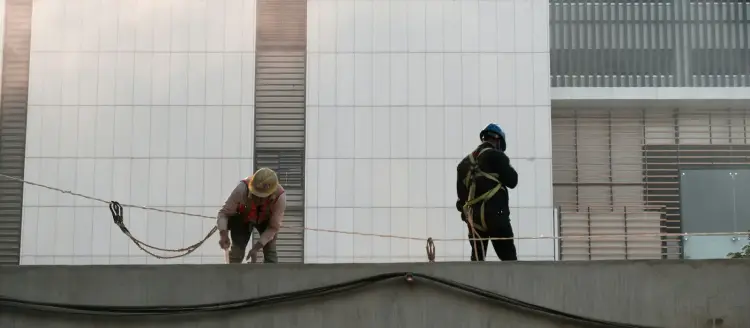Safety Best Practices
Stefano Braganti
Real-Time Workforce Visibility Ends Labor Drift & Rework
Labor drift, rework and schedule slips thrive when you can't see head-count live. Learn how smart turnstiles & dashboards give GCs real-time visibility.

The advent of summer brings a unique set of challenges for the construction industry. The benefits of prolonged daylight hours are often overshadowed by the serious implications of extreme heat and high humidity, leading to a potential increase in heat-related health issues among workers.
Health risks related to high-temperature exposure for construction workers can range from mild heat rashes and cramps to severe conditions like heat exhaustion. The latter could disrupt focus, trigger mood swings, induce sickness, and even cause a loss of desire to drink. If left untreated, heat exhaustion can escalate to heatstroke, which can be fatal or result in long-lasting damage to brain and other organs.
In addition, the extreme summer heat can adversely affect the workflow and efficiency on a construction site. Tools and equipment may need to operate at their upper temperature limits, intensifying maintenance needs and reducing the leeway for any deferred upkeep. Building materials are susceptible to deformation, discoloration, and even melting. Concrete application becomes more challenging, with a higher likelihood of cracking. All these factors can cause a slowdown in productivity, unexpected schedule delays, and increased chances of accidents and associated claims.
Proactive planning is essential in minimizing these risks and ensuring a safe and productive work environment, even under the scorching summer sun.
Formulating a heat management strategy should be integral to project planning. This includes considering additional needs such as temporary cooling solutions for construction sites where the HVAC system is yet to be installed.
Outdoor activities in direct sunlight entail their own challenges. Proactive measures like deploying shade cloth, ensuring availability of cooling towels, and providing easy access to water can make a significant difference. Additionally, the varying degrees of heat risks associated with different tasks should be assessed and addressed appropriately.
Adopting administrative and engineering controls can help reduce heat-related hazards. This might mean implementing air conditioning and ventilation where possible to reduce workspace heat and humidity. Work schedules could be adjusted to ensure labor-intensive activities are carried out during the cooler parts of the day. Scheduled rest periods, ensuring adequate water supply, and allowing workers to gradually acclimatize to the heat are also effective approaches.
Proper care and maintenance of equipment and tools are essential, given that they'll be operating under high-temperature conditions. Implementing frequent maintenance schedules and providing shade for tools, fuel, and batteries can significantly reduce the risk of heat-related malfunctions. Proper planning of material storage and timely delivery can prevent damage from improper storage and also lessen the heat exposure of workers handling the materials.
It's imperative to educate workers to recognize the early signs of heat illness. Conditions such as high humidity, intense physical labor, poor air circulation, and the use of protective gear can significantly increase the risk of heat-related illnesses. Understanding these risk factors and their cumulative effects is key to preventing severe heat-induced health problems.
Potential environmental risks may include soaring temperatures, high humidity, radiant heat from machinery and materials, contact with hot objects, direct exposure to sunlight without shade, and limited airflow. Meanwhile, job-specific risks usually involve strenuous physical activity and the use of non-breathable protective clothing and equipment. A comprehensive understanding of these factors is essential for averting heat-related health crises.
Educating workers on how to identify signs of heat-related illnesses like heat exhaustion and heatstroke, and to take necessary preventive and remedial actions, can substantially decrease the likelihood of serious health issues. Initial signs of heat-related problems may include muscle cramps, pain, and spasms. Individuals experiencing these symptoms should seek rest in a cool place and rehydrate with clear liquids such as juice, sports drinks, or water with food.
Heat exhaustion, resulting from the body's substantial loss of water and salt, is characterized by symptoms such as fatigue, dizziness, headache, nausea or vomiting, excessive sweating, and pale and clammy skin. Changes in skin color may be less noticeable on darker skin. Other symptoms can include cramps in the arms, legs, and stomach, rapid breathing or heartbeat, high body temperature, intense thirst, and weakness. In children, irritability can also signal heat exhaustion.
If someone exhibits signs of heat exhaustion, they need immediate cooling and rehydration. Follow these steps:
In severe cases, heatstroke may occur, characterized by high body temperature, confusion, impaired coordination, hot, or excessively sweating skin, intense headache, seizures, and even coma. In such situations, immediately call for emergency medical services. Heatstroke is a medical emergency requiring urgent attention.
Understanding the risks associated with extreme heat and adopting preventive measures is essential for the health and safety of everyone in the construction industry. Arm yourself with the knowledge and the right resources to beat the heat this summer.
The objective extends beyond project completion - it's about safeguarding the wellbeing of all involved and ensuring everyone gets home safe each day. Be proactive, be informed, and make smart decisions to stay cool and safe throughout the summer season.

Senior Safety Coordinator devoted to creating secure environments and ensuring workplace well-being.
Safety Best Practices
Stefano Braganti
Labor drift, rework and schedule slips thrive when you can't see head-count live. Learn how smart turnstiles & dashboards give GCs real-time visibility.

Safety Best Practices
Stefano Braganti
Stop-Work Orders crush margins. Digital safety dashboards catch risks early, prevent claims, and protect your 3% fee.

Safety Best Practices
Stefano Braganti
NYC DOB formalizes digital record-keeping: what the bulletin says, why it matters, and how SafetyClerk helped make it happen.

together
SafetyClerk is the construction management platform that makes safety compliance, and risk management of your job site simple and visible in one click.
Stay on
the loop!
ConstructionClerk - 2025 - All rights reserved
ConstructionClerk - 2025 - All rights reserved